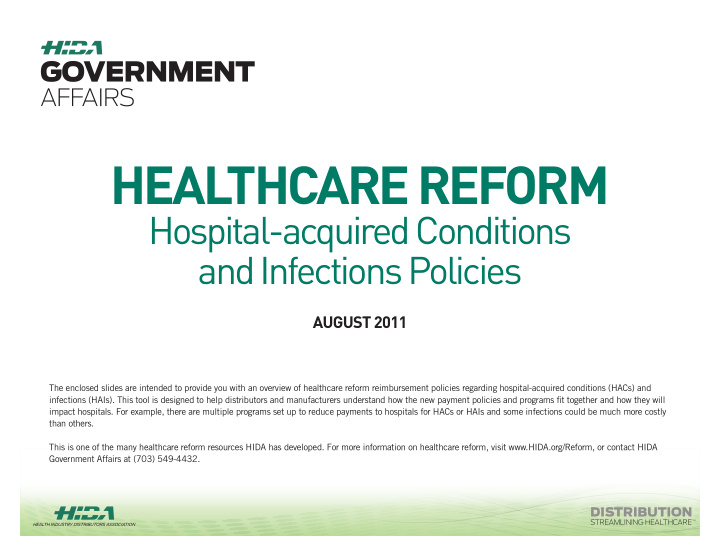



HEALTHCARE REFORM Hospital-acquired Conditions and Infections Policies AUGUST 2011 The enclosed slides are intended to provide you with an overview of healthcare reform reimbursement policies regarding hospital-acquired conditions (HACs) and infections (HAIs). This tool is designed to help distributors and manufacturers understand how the new payment policies and programs fit together and how they will impact hospitals. For example, there are multiple programs set up to reduce payments to hospitals for HACs or HAIs and some infections could be much more costly than others. This is one of the many healthcare reform resources HIDA has developed. For more information on healthcare reform, visit www.HIDA.org/Reform, or contact HIDA Government Affairs at (703) 549-4432. DISTRIBUTION DISTRIBUTION STREAMLINING HEALTHCARE SM
• Healthcare reform to incentivize hospitals infection rates • Hospital-acquired conditions (HACs) • Hospital-acquired infections (HAIs) to drastically reduce includes a HAC reimbursement policy HACs vs. HAIs Serious conditions that patients contract during a hospital stay Serious infections that patients contract during a hospital stay HACs HAIs All HAIs are HACs, but not all HACs are HAIs DISTRIBUTION DISTRIBUTION STREAMLINING HEALTHCARE SM
NO END-GAME FOR HACs • Begins in 2015; the program continues indefinitely (as there is no expiration or sunset date), no matter how low infection rates are in the future • 1% cut across-the-board to hospitals in the top quartile of national infection rates (infections and rates are to be determined in regulatory rulemaking process) • Projected to save $1.4 billion over 10 years • HHS required to submit a report to Congress with with regard to establishing a HAC policy in post-acute settings DISTRIBUTION DISTRIBUTION STREAMLINING HEALTHCARE SM
MULTIPLE PENALTIES = 1 INFECTION * A single infection could result in multiple penalties due to the implementation of additional programs that penalize for HACs (for example, value-based purchasing, Medicare and Medicaid policies to reduce preventable medical errors, and accountable care organizations) Medicare Value-based 1% cut per health Medicaid preventable Proposed ACO quality (not eligible for higher purchasing reform policy conditions measures Hospital-acquired Conditions payment per IPPS) (FY2008) (FY2013) (FY 2015)** (July 1, 2012) (Jan. 1, 2012) Catheter associated UTI X X ? X X Surgical site infections X X ? X X Foreign object retained after surgery X X ? X X Air embolism X ? X X Blood incompatibility X ? X X Pressure ulcer stages III or IV X ? X X Falls and trauma X ? X X DVT/PE after hip/knee replacement X ? X X Manifestations of poor glycemic control X ? X X Ventilator associated pneumonia X ? MRSA X ? Clostridium difficile X ? Central line assoc. blood steam infection X * This table is meant to provide a snapshot of HAC/HAI only. Details on all the HAI quality measures, which include specific surgeries and patient safety indicators that affect market basket updates and value-based purchasing payments for hospitals, can be found on the Centers for Medicare and Medicaid Services (CMS) Web site at www.cms.gov. Direct links to the various programs are imbedded in the table above. ** CMS has not yet proposed regulations to implement infection policies included in healthcare reform. DISTRIBUTION DISTRIBUTION STREAMLINING HEALTHCARE SM
Recommend
More recommend